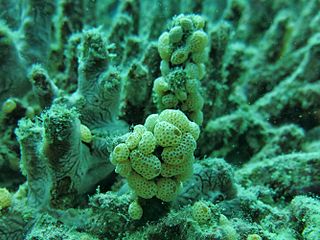
Clavelinidae is a family of tunicates in the order Aplousobranchia.

Didemnum is a genus of colonial tunicates in the family Didemnidae. It is the most speciose genus in the didemnid family. Species in this genus often have small calcareous spicules embedded in the tunic and form irregular or lobed colonies. Some Didemnum species, including Didemnum vexillum and Didemnum perlucidem are considered invasive species. In early 2006, Didemnum vexillum was found covering a 230 km2 area of cobble habitat in Georges Bank off the coast of New England, and is classified as an invasive species of greatest concern in coastal areas throughout Europe, New Zealand, and North America. Didemnum sp. invasions have also been recorded in Canada, the Mediterranean, and the Netherlands.

Elseya is a genus of large side-necked turtles, commonly known as Australian snapping turtles, in the family Chelidae. Species in the genus Elseya are found in river systems in northern and northeastern Australia and throughout the river systems of New Guinea. They are identified by the presence of alveolar ridges on the triturating surfaces of the mouth and the presence of a complex bridge strut.

Aplousobranchia is an order of sea squirts in the class Ascidiacea, first described by Fernando Lahille in 1886. They are colonial animals, and are distinguished from other sea squirts by the presence of relatively simple pharyngeal baskets. This provides the etymology of their name: in ancient greek, ἁ.πλοος-ους (ha.ploos-ous) means "simple". The posterior part of the abdomen contains the heart and gonads, and is typically larger than in other sea squirts.

Pycnoclavella diminuta, known as the white-spotted sea squirt, white-spot ascidian, and white-spotted ascidian, is a species of tunicate, in the genus Pycnoclavella. Like all ascidians, these sessile animals are filter feeders.

Anne Patricia Jones is an Australian writer, editor, and administrator. She is one of two working directors of ToadShow Pty Ltd, a Brisbane-based design company, where she is managing partner and company chair. In 1981 she was co editor of Semper Floreat the University of Queensland student newspaper.
Patricia Mather was an Australian zoologist and taxonomist known for her research into sea squirts. She became a leader in Australian marine science and achieved international status through her work on the Ascidiacea. She has published more than 150 papers including a major monograph on the "Australian Ascidiacea".

Atriolum is a genus of colonial tunicates in the order Aplousobranchia, first described in 1983 by Patricia Kott. These are marine animals found attached to the seabed or some other surface.
Orraya is a monotypic genus of lizard in the family Carphodactylidae. The genus contains the sole species Orraya occultus, also known commonly as the McIlwraith leaf-tailed gecko or the long-necked northern leaf-tailed gecko. The species is endemic to Australia.
Cymbastela stipitata is a species of marine sponge in the family Axinellidae.
Cymbastela coralliophila is a species of marine sponge in the family Axinellidae.

Pseudodistomidae is a family of tunicates belonging to the order Aplousobranchia.

Sycozoa cerebriformis, is a sea squirt in the family Holozoidae, first described by Jean René Constant Quoy and Joseph Paul Gaimard in 1834 as Aplidie cerebriforme. The taxonomic decision which determined the name, Sycozoa cerebriformis, and the species' synonymy was given by Patricia Kott in 1990.

Sycozoa pulchra, is a sea squirt in the family Holozoidae, first described by William Abbott Herdman in 1886 as Colella pulchra. The taxonomic decision which determined the name, Sycozoa pulchra, and the species' synonymy was given by Patricia Kott in 1990.

Soestia is a monotypic genus of tunicates belonging to the family Salpidae. The genus was described by Patricia Kott in 1998. The only species is Soestia zonaria, which was first described in 1774 by Peter Simon Pallas as Holothurium zonarium.
Thora Patricia Whitehead was an Australian scientific collector and malacologist. She collected more than 200,000 shell specimens which are now held in the Queensland Museum.
Adagnesia is a genus of tunicates in the family Agneziidae, first described in 1963 by Patricia Kott. The type species is Adagnesia opaca Kott, 1963.
Adagnesia opaca is a species of tunicate in the family Agneziidae, first described by Patricia Kott in 1963.
Adagnesia venusta is a species of tunicate in the family Agneziidae, first described by Patricia Kott in 1985.

Pyura gibbosa is a species of sea-squirt in the family, Pyuridae, and was first described in 1878 as Cynthia gibbosa by Camill Heller.












